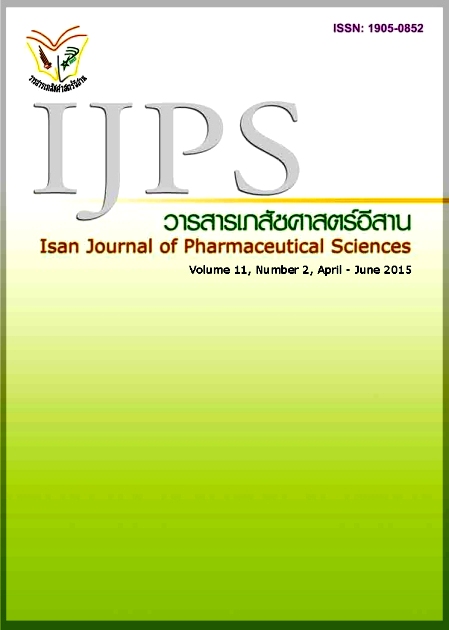Quality of service determined by the community pharmacy association’s quality indicators between accredited and non-accredited pharmacies in the north-eastern part of Thailand
Main Article Content
Abstract
Introduction There has been a perception that the quality of services in community pharmacies in the Thailand are varied, but it has never been determined by objective indicators. The Community Pharmacy Association (Thailand) has developed quality indicators aims to be a self assessment tool for quality improvement. This tool has not been widely used yet. Aims of study This study aimed to determine the reliability of this quality tool and to compare the quality scores between accredited community pharmacies and non accredited community pharmacies in the north east of Thailand using quality indicators developed by the Community Pharmacy Association (Thailand). Materials and Methods The cross-sectional qualitative method was employed by using individual interview and observational method in 30 accredited and 30 non-accredited pharmacies, which were paired to the nearest setting of the accredited ones. Data were collected in 5 dimensions consisted of 40 items altogether. Data collection was performed during November 2013 to January 2014. The reliability of the quality indicator tool was tested by Cronbach’s alpha coefficient. The differences between the two pharmacies were tested by Pearson Chi Square, Fisher’s Exact Test, Independent T-test, or Mann-Whitney U test according to the characteristics of data. Results Cronbach’s alpha coefficient was 0.87, which meant that the indicators were reliable to assess the quality of the community pharmacies. There were significant differences in years of owning the business (p = 0.002), pharmacists’ age (p = 0.001), and year of experiences in community pharmacies (p = 0.005) between the two groups. Considering the scores of each dimension, the accredited pharmacies had higher scores than the non-accredited ones in every dimension of 1-5; p < 0.001, p = 0.018, p = 0.004, p< 0.001 and p < 0.001 respectively. Comparing each item of the quality indicators by mean, median and mode showed that accredited community pharmacies had higher scores than the non accredited community pharmacies in most of the items. Some items were comparatively equal in the two groups, but no such item that the accredited one was scored lower than the non accredited one. Conclusions The quality indicators developed by the Community Pharmacy Association (Thailand) had a good reliability. The quality scores, determined by this quality tool, showed that accredited community pharmacies were higher than the non accredited community pharmacies.
Article Details
In the case that some parts are used by others The author must Confirm that obtaining permission to use some of the original authors. And must attach evidence That the permission has been included
References
Boonchoong N, Chanakij T, Dorkrakklang P, Wongsa P, Sootsol S, Yospanya S. Compliance with the community pharmacy project after accreditation by the Pharmacy Council. KKU Res J 2007; 12(1): 53-65.
Community Pharmacy Association (Thailand). Quality indicators tools for assessment of quality in communitypharmacies. [Online]. 2012 Apr 22 [cited 2012 Oct 31]. Available from http://www.pharcpa.com/files/20120422_GPP_Quality_Indicator.doc.
De Bie J, Kijlstra NB, Daemen BJ, Bouvy ML. The development of quality indicators for community pharmacycare. BMJ Quality & Safety 2011; 20(8): 666-671.
Food and Drug Administration, Thailand. Good Pharmacy Practice: GPP [Online]. 2014 May 13 [cited 2014 May 13]. Available from: https://drug.fda.moph.go.th/zone_law/files/GPP.pdf.
Gokcekus L, Toklu HZ, Demirdamar R, Gumusel B. Dispensing practice in the community pharmacies in the Turkish republic of northern Cyprus. International Journal of Clinical Pharmacy 2012; 34(2): 312-324.
Health-related quality of life: assessment and application. 1st ed. Khon Kaen: Khon Kaen University printing house; 2009. 55-84.
Jarernsiripornkul N, Chaisrisawadsuk S, Chaiyakum A, Krska J. Patient self-reporting of potential adverse drug reactions to non-steroidal anti-inflammatory drugs in Thailand. Pharmacy World & Science 2009; 31(5):559-564.


